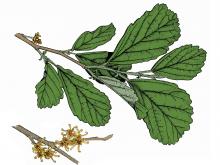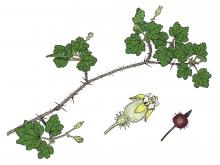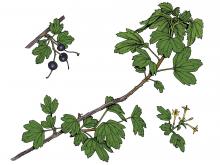Trees, Shrubs and Woody Vines
Media

Species Types
Scientific Name
Rhus spp.
Description
Sumacs are shrubs or small trees that often form colonies from their creeping, branched roots. The foliage usually turns brilliant shades of red in early autumn. The clusters of berrylike fruits are red.
Media

Species Types
Scientific Name
Hamamelis vernalis
Description
Ozark witch-hazel is a large native shrub that grows along dry, rocky streambeds in southern and east-central Missouri. The yellow, ribbonlike flowers bloom as early as January. In the fall, the seeds are ejected forcefully, to a distance of up to 30 feet!
Media

Species Types
Scientific Name
Toxicodendron radicans
Description
Poison ivy is a toxic plant that contains an oil in all its parts that, if you come into contact with it, can cause an intense skin reaction. Learn to recognize it, and sidestep it on your outings.
Media

Species Types
Scientific Name
Ribes missouriense
Description
Missouri gooseberry is our state’s most widespread and common gooseberry. People brave its prickly stems to collect its tart, tasty fruits to make pies, jams, and jellies.
Media

Species Types
Scientific Name
Quercus spp.
Description
Oaks are the most important group of trees in Missouri, in both human and ecosystem value. They dominate most of the forests, woodlands, and savannas in the state. Learn more about our 22 species.
Media

Species Types
Scientific Name
Ribes cynosbati
Description
Prickly gooseberry occurs mostly in the eastern half of Missouri. Its spine-covered berries turn reddish purple when ripe. Despite the prickles, they are edible.
Media

Species Types
Scientific Name
Ribes odoratum (syn. R. aureum)
Description
Golden currant is an erect to arching, spineless shrub up to 6 feet high that bears edible fruit. It is uncommon in the western part of the Ozarks. The flowers have a strong fragrance reminiscent of spicy cloves or sweet carnations.
See Also
About Trees, Shrubs and Woody Vines in Missouri
There are no sharp dividing lines between trees, shrubs, and woody vines, or even between woody and nonwoody plants. “Wood” is a type of tissue made of cellulose and lignin that many plants develop as they mature — whether they are “woody” or not. Trees are woody plants over 13 feet tall with a single trunk. Shrubs are less than 13 feet tall, with multiple stems. Vines require support or else sprawl over the ground.





















